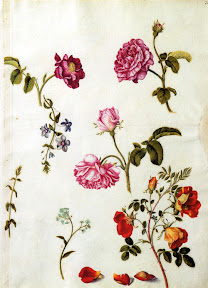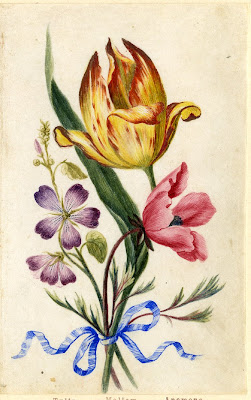Alexander Marshall's botanical illustrations
Alexander Marshal (Marshall) (c.1620-1682) was one of a circle of gentleman gardeners, centred on London, for whom the cultivation of rare plants was essential to the study of the natural world. Their interest was stimulated by the previously unknown specimens imported to England from the Near East and the New World in the seventeenth century.


***
Tulips,anemones,irises,roses etc
Watercolour over metalpoint, shaded with grey wash, on vellum
© The Trustees of the British Museum




+





























***
Tate Online (Britain)
David Attenborough on Alexander Marshall (1620 - 1682)
"Artists over the centuries have painted flowers for several reasons. Some of the earliest were produced to illustrate the herbals - first manuscripts and later printed books that enabled people to identify the plants they needed as food or medicines. Their pictures were formal, almost diagrammatic, but they served their purpose well. In Holland during the seventeenth century artists depicted flowers in a very different way. They revelled in realism. They delineated every hair on a stem, every glistening dewdrop on a leaf, every spot of decay. For them, it seems, this was a way of showing off their extraordinary painterly skills.
But Alexander Marshal, an Englishman who was painting at around the same time, had quite different motives. His pictures were not intended to serve as identification guides or catalogues. Nor did he use them to demonstrate his skills. How can we know that? Because he declined to show them to the world at large. He revealed them only to his close friends.
Marshal had private means. He collected natural history objects, particularly insects. And he was a devoted gardener. In his time, great numbers of new species of flowering plants were arriving in Britain, not only from Europe, but also from the recently discovered Americas, and Marshal had a hand in importing them and supplying them to the great gardens of the country. And he painted them. Some of his sheets of drawings show garden plants arranged in ordered rows. Others, rather less formal, illustrate flowers from the countryside. And among them, drawn to a different scale but with an equal care, are pictures of his insects - a dragonfly, a caterpillar, a stag beetle - and his pets: a greyhound, an African parrot which he shows several times, gaudy macaws and a marmoset from South America.
He worked relatively slowly. At the end of his life, after 30 years of painting, he had accumulated only 159 sheets. People who knew of them tried to buy them, but he refused all offers. After his death his “florilegium”, as he called it, remained in his family for several generations. It is now in the Royal Collection. They still seem like private documents, un-showy and modest, yet close to perfection. If he did not paint his pictures to scale, nor to serve as a key to identification, nor even to demonstrate his ability to others, why did he paint? As you look at them, and delight in the skill with which he records every curl and contour of a petal and the way he mixes his flowers with other objects that he held dear, his motive, surely, cannot be in doubt.
Alexander Marshal painted for love."(c)
Alexander Marshall
Unnamed (cabbage rose); the English snake: Unnamed (Drinker moth caterpillar larva) c. 1650 - 1682
Courtesy The Royal Collection © 2011 Her Majesty Queen Elizabeth II
Watercolour on paper 35x25cm

***
The Florilegium of Alexander Marshal (c.1620-82)

This enchanting new publication celebrates the work of Alexander Marshal and his exquisite Florilegium, the only surviving example of a 17th-century English flower-book. It takes the reader through a year in the life of an English garden, from the snowdrops and crocuses of early spring to autumnal gourds and Chinese lanterns. Although little known today, Alexander Marshal was one of the most extraordinary botanical artists of his time. Mr Marshal’s Flower Book, the first popular introduction to the artist’s life and work, will delight garden enthusiasts and art-lovers alike.
It is published to coincide with the exhibition Amazing Rare Things: The Art of Natural History in the Age of Discovery at The Queen’s Gallery, Buckingham Palace (until 28 September 2008), which has been curated in collaboration with the distinguished naturalist and broadcaster Sir David Attenborough.
Royal Collection-Amazing rare things
Alexander Marshal (c.1620-1682) was one of a circle of gentleman gardeners, centred on London, for whom the cultivation of rare plants was essential to the study of the natural world. Their interest was stimulated by the previously unknown specimens imported to England from the Near East and the New World in the seventeenth century.
Over a period of thirty years Marshal compiled a ‘florilegium’ (flower book) of 154 folios recording plants growing in English gardens. Of the numerous species depicted, many are exotic newcomers; others are native plants. Although Marshal was not a professional artist, his florilegium - the only English flower book to survive from the period - contains some of the most beautiful plant studies in botanical art. The watercolours were not intended for publication or sale, but to be studied and enjoyed by his friends and fellow horticulturalists.
Marshal’s florilegium was presented to George IV in the 1820s.

Velvet rose, unidentified rose, flaxleaf pimpernel, damask rose, water forget-me-not, and Austrian copper rose

***

***




***






This entry was originally posted at http://elle-belle.dreamwidth.org/1685206.html. Please comment there using OpenID.